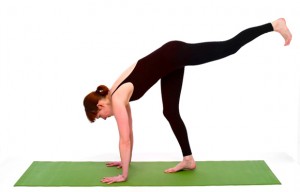 The lumbar curve is one of the special gifts of being human. We are upright and walking— and in some ways talking –because we have a curve in the bones of the lower spine between the pelvis and the rib cage. The curve in the lower back allows the weight of the trunk to sit upright on top of the pelvis. Because of the curves in the span of the spine, weight of the upper body can transfer down through the hips and legs.
The lumbar curve is one of the special gifts of being human. We are upright and walking— and in some ways talking –because we have a curve in the bones of the lower spine between the pelvis and the rib cage. The curve in the lower back allows the weight of the trunk to sit upright on top of the pelvis. Because of the curves in the span of the spine, weight of the upper body can transfer down through the hips and legs.
We can use our gaze in handstand to help the lower spine to find its curve. When the neck curves the lower back curves as well. The spine has four curves; two that curve in and two that curve out. The lower back and the neck both curve in a tiny bit. The curves, as important as they are, don’t need to be big in degree. In fact, they should be as small as possible which requires a great deal of balanced muscle tone.
The curve of the lower back and the neck are meant to be mirror images of each other—they should have the exact same degree of curve. If you read last week’s posts about forward head posture, you know that this is rarely happening.
Handstands require a curve the in the lower spine like everything else. For many students the quality and stability of the lumbar curve is a big problem. We need a stable spine with a curve in the lower back for a number of reasons. Without a solid spine it is not likely that the hips will get over the shoulders. It is not likely that the psoas can work correctly and without a curve in the lumbar spine it is very difficult to find a solid spine. We’ll come back to this at a later date.
Learning handstands can be maddening. Going upside down has the ability to throw off our equilibrium to a greater degree than it should and there are a lot of mechanical aspects to try and figure out that can be very confusing. We also tend to focus on the act of kicking a lot so that many students don’t think too much about where their eyes should be.
If the lumbar curve and the cervical curve are mirror images of each other they need to maintain that balance in order to go up into handstand. What often happens is the ears don’t stay in line with the shoulder and the head curls forward drawing the chin towards the chest. In this case the eyes look away from the hands— flattening the curve of the neck which will also flatten the curve of the lower back.
If you keep your gaze on the thumbs the entire time you are working towards handstand you will have a much easier time finding an alignment of the spine that will facilitate your handstands.
